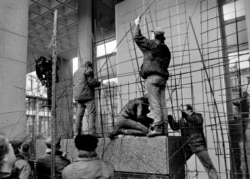Lithuanian politicians sing their country’s anthem seconds after declaring independence from the Soviet Union in Lithuania’s parliament at 10:44 p.m. on March 11, 1990.
Lithuanians tear a Soviet emblem from the entrance of parliament after independence was declared.
A banner of the ancient Lithuanian emblem known as Vytis being hung inside parliament to replace the Soviet hammer and sickle.
These dramatic scenes from the first moments of Lithuanian independence were captured by Vytautas Daraskevicius, a Vilnius radio engineer and amateur photographer. Beginning in 1988, Daraskevicius (above) used his Olympus camera and Soviet-made film to document the momentous political events taking place in his country. By 1988, he told RFE/RL, “We could see the moment [of Lithuania declaring independence] was coming.”
In the months leading up to March 11, Daraskevicius photographed on the streets as people tested the limits of the reformist rule of Soviet leader Mikhail Gorbachev. The Vilnius crowd above is protesting conscription into the Soviet Army in February 1989 -- a show of dissent that would have been unthinkable before Gorbachev’s rise to power.
Demonstrators calling for Lithuanian independence in January 1990.
Shortly after Daraskevicius made this picture, elections were held that resulted in a massively popular pro-independence movement gaining seats in Lithuania’s Supreme Soviet.
Crowds gather outside Lithuania’s parliament on March 11, 1990.
Daraskevicius says that without a press pass he was unable to enter the building as a vote on declaring independence was held.
Crowds gather outside parliament after nightfall.
Soon after he shot this photo, Daraskevicius says “a man came out from the parliament and asked, 'Are there any photographers here?’” The vote had just been taken to declare independence and Daraskevicius was ushered into the parliament chamber to record the history unfolding inside.
Lawmakers applaud after the declaration of independence and the singing of Lithuania’s national anthem. The digital clock (top left) shows three minutes have passed since the independence announcement.
Lithuanian lawmakers applaud the vote.
Pro-independence leader and politician Vytautas Landsbergis is cheered after the declaration.
A Soviet emblem with the hammer and sickle is carried out of parliament.
Daraskevicius says the emblem “was put on the floor, then I don’t know what happened to it. Perhaps it is in some museum somewhere.”
But despite the political earthquake of March 11, little changed on the ground in Lithuania. Soviet soldiers still occupied the country and a closely guarded Lenin monument still stood in central Vilnius. Daraskevicius’s work documenting his country’s path to independence was not over.
Armed Lithuanian militiamen guarding the roof of the parliament building in February 1991.
One month earlier, the Kremlin had launched a military assault on various strategic points in Lithuania in an attempt to wrest back control of the country. Fourteen civilians, including a young woman, were killed defending the Vilnius television tower.
Men erect a barricade outside Lithuania’s parliament building in January 1991.
Many assumed Lithuania’s parliament building would be the next target of the Soviet military.
Lithuanians relaxing inside the parliament building.
Daraskevicius says the men -- some of hundreds who were stationed inside parliament in expectation of a Soviet attack -- “were prepared to die” to defend the building.
Militiamen inside parliament pose with shotguns in February 1991.
Daraskevicius jokes, “You can say I took the first photos of Lithuania’s military.”
A lens for a laser that was given to the defenders of the parliament by a nearby physics institute. Daraskevicius says the optical “weapon” was used to dazzle Soviet helicopter pilots who veered sharply away when the laser was directed at them and didn’t return.
In August 1991, anticipation of an attack on Lithuania eased as a failed coup attempt by communist hard-liners in Moscow plunged the Soviet leadership into chaos.
Lithuania took advantage of the Moscow turmoil by banning the Communist Party and arresting its chief. That month, Daraskevicius photographed a Lenin monument (above) in the center of Vilnius being torn down.
Four months later, the U.S.S.R. ceased to exist as one Soviet republic after another declared its independence.

























